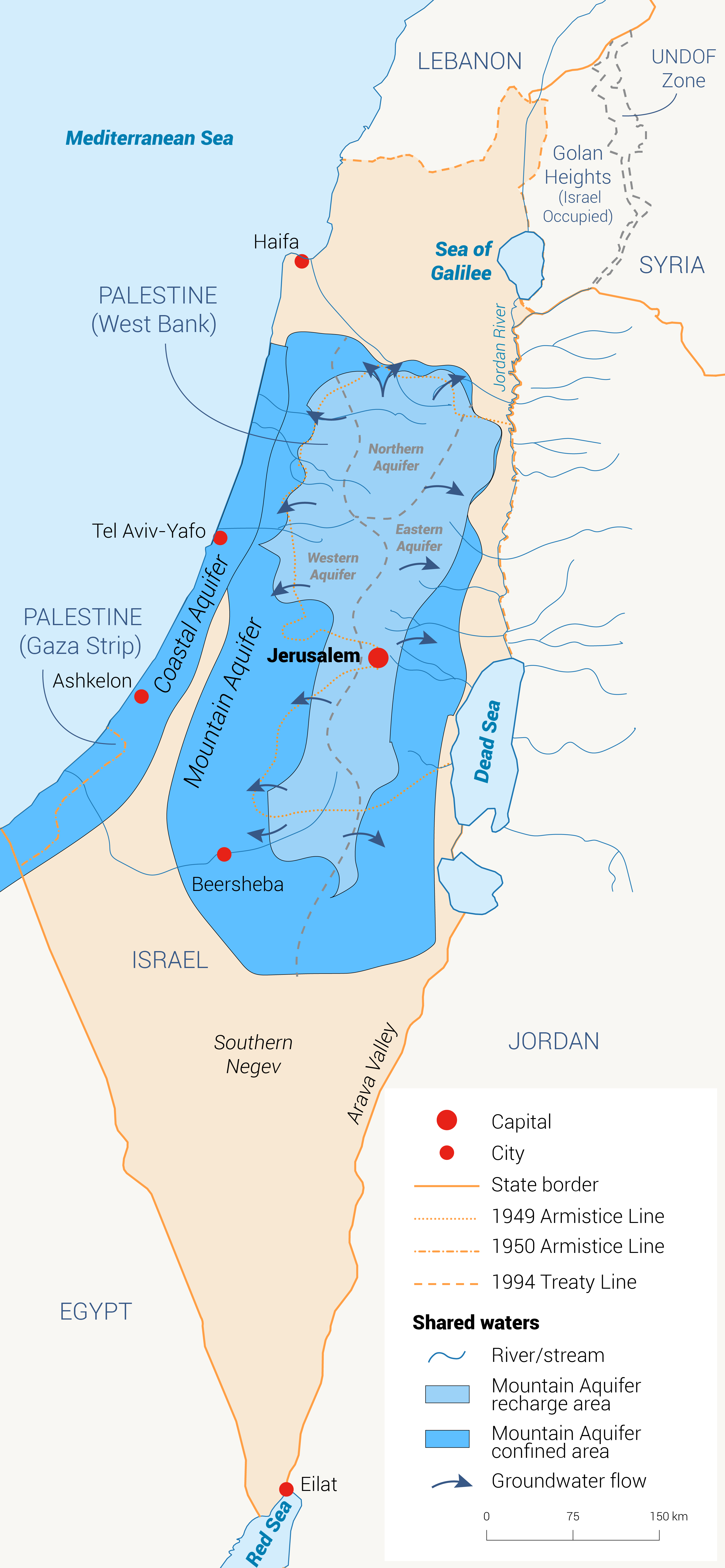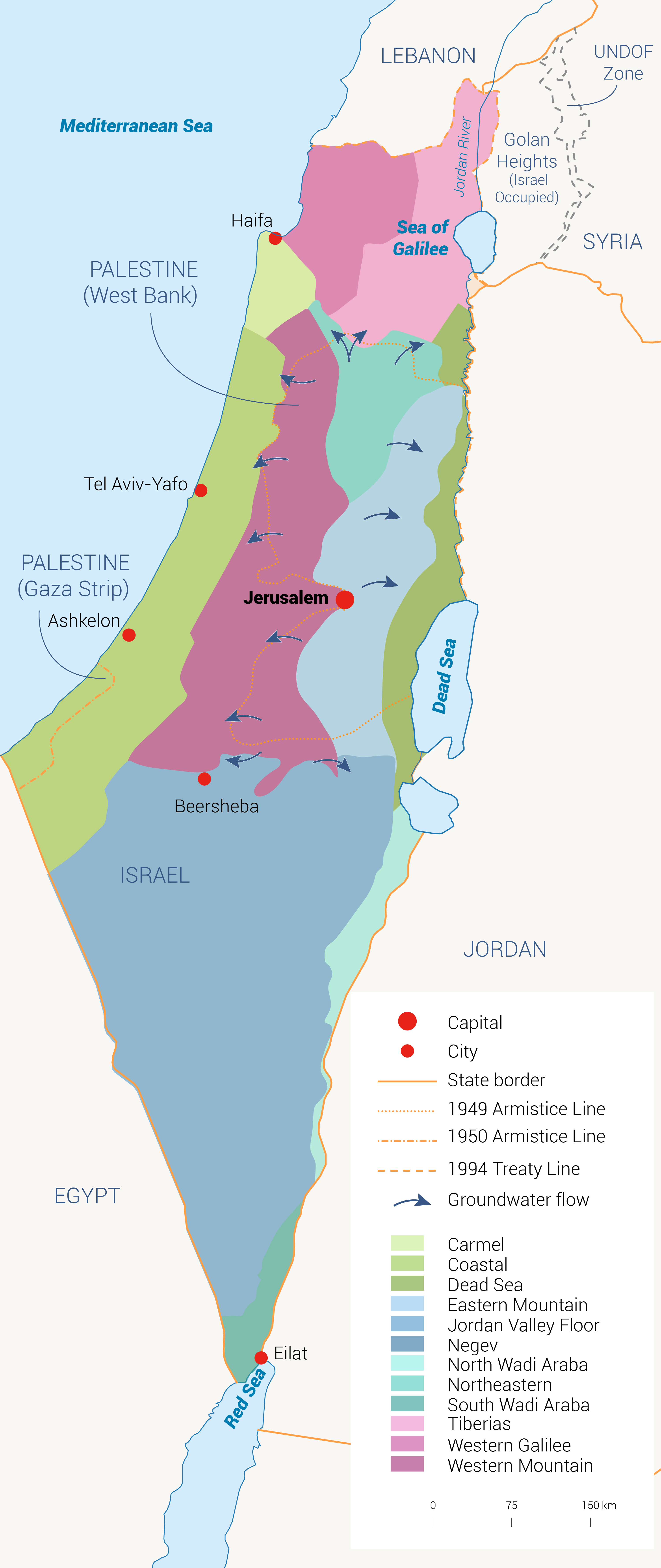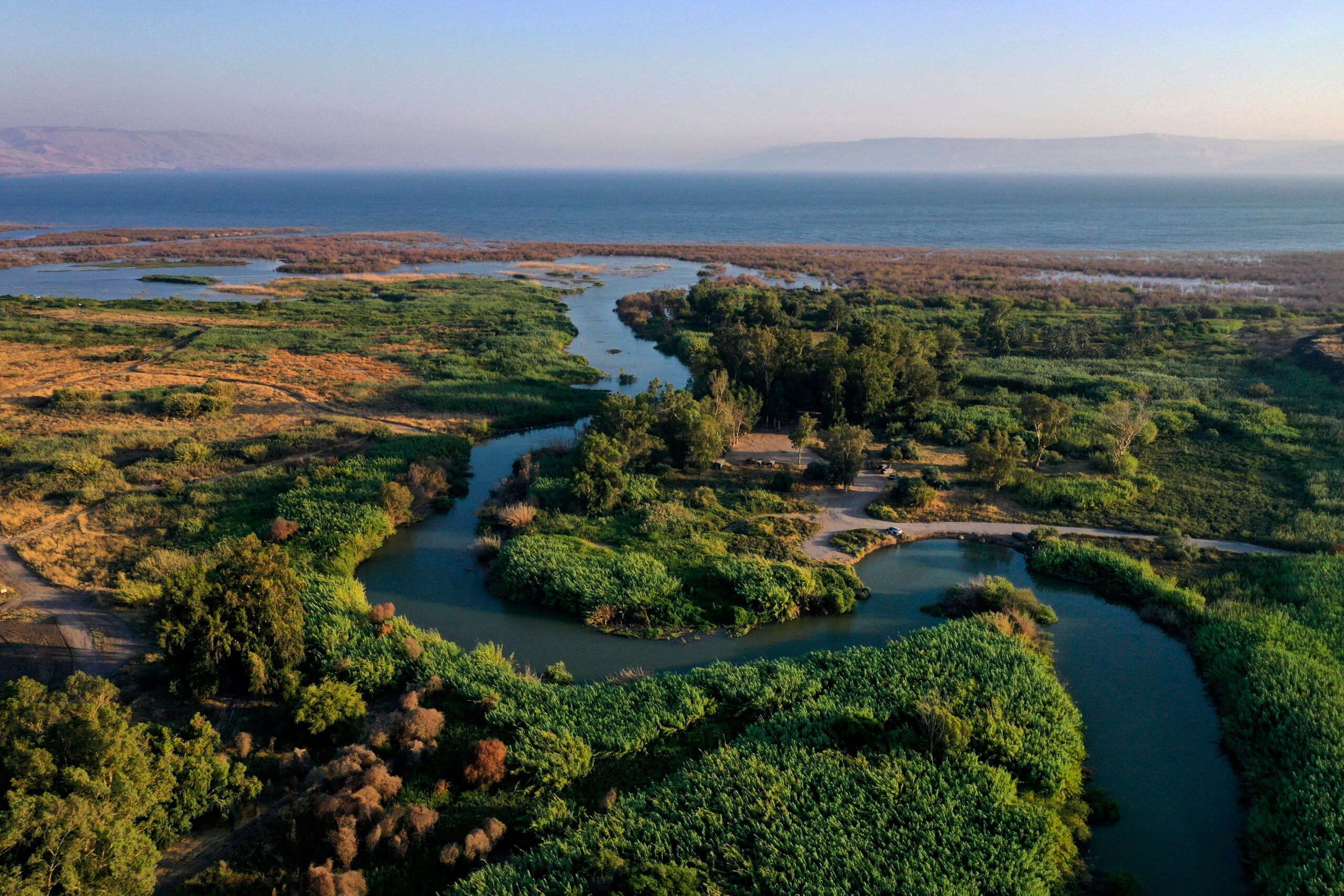
The main freshwater resources in Israel are the Sea of Galilee, the Jordan River, the Coastal Aquifer and the Mountain Aquifer (Map 1). Surface and groundwater still form the main sources of water supply.[1] However, recent developments in desalination and wastewater reuse technology herald a shift away from natural to alternative sources, so that Israel will be able to meet future demand while protecting its natural water resources.
Israel has several groundwater aquifers, chiefly the Mountain Aquifer and the Coastal Aquifer, but also smaller and more local aquifers like the Western Galilee Aquifer, Arava and Negev Aquifer, Carmel Aquifer and Northern Galilee Aquifer.
Surface water
Sea of Galilee
The Sea of Galilee is located in the Jordan Valley in the north-east of Israel. Situated at an altitude of 213 metres below sea level, the Sea of Galilee is the world’s lowest freshwater lake. The main source of water to the lake is rain and snowfall from the Upper Galilee and Golan Heights. The lake serves as an operational reservoir and source of water supply to the national system. It used to supply about a quarter of the annual amount of water consumed in Israel.
The Sea of Galilee was a source of military conflict between Israel and Syria, known as the Water War. Today, the lake provides only between 2-13% of Israeli water consumption. This is due on the one hand to the drop in water levels following successive years of drought, and on the other hand to the establishment of several desalination plants on the Mediterranean coast. The water level of the lake is monitored each day. If the level is too low, it is forbidden to pump water for fear of damaging the ecosystem or affecting the water quality.
In 2023, Israel completed the National Carrier Flow Reversal Project. Whereas the National Water Carrier has for decades carried water from the Sea of Galilee in the north to consumers in the south, the so-called New National Water Carrier can now transport water from the desalination plants in the centre of the country to the Sea of Galilee. This is expected to stabilize the water level of the lake, deliver large quantities of water to Jordan and achieve water security for Israel.
Jordan River
The Jordan River originates from three main springs: the Banias in the Golan Heights, the Dan in Israel and the Hasbani in Lebanon. With a total length of 360 kilometres (km), the river flows south to the Sea of Galilee and discharges in the Dead Sea. The river is divided into the Upper Jordan River (from the confluence of the Banias, Dan and Hasbani to the Sea of Galilee) and the Lower Jordan River (from the Sea of Galilee to the Dead Sea).
The construction of dams and diversion projects in the Jordan River Basin has caused a 96% decline in the flow of the Lower Jordan River. This water is highly polluted and saline due to sewage, saline springs and runoff from agricultural fields. Consequently, half of the original biodiversity has been lost, and much of the rest is endangered. In addition, the river no longer delivers the ecological services it once provided. The decline of the Lower Jordan River has had a direct impact on the level of the Dead Sea, which has lost a significant part of its surface area.
Yarmouk River
The Yarmouk River, the main tributary of the Jordan River, originates in Syria and discharges in the Lower Jordan River. The Yarmouk River Basin covers an area of nearly 7,000 km2 and is shared between Israel, Jordan and Syria. The river’s annual flow has dropped sharply over the past decades from around 450-500 MCM to 40 MCM due to extensive dam construction on the river in Syria and groundwater pumping in the upper parts of the basin in Israel, Jordan and Syria. Jordan also diverts a part of the flow through the King Abdullah Canal for irrigation in the eastern Jordan River Valley.
There are several smaller streams in Israel, such as the Kishon River and Yarkon River, which are not described in this report.
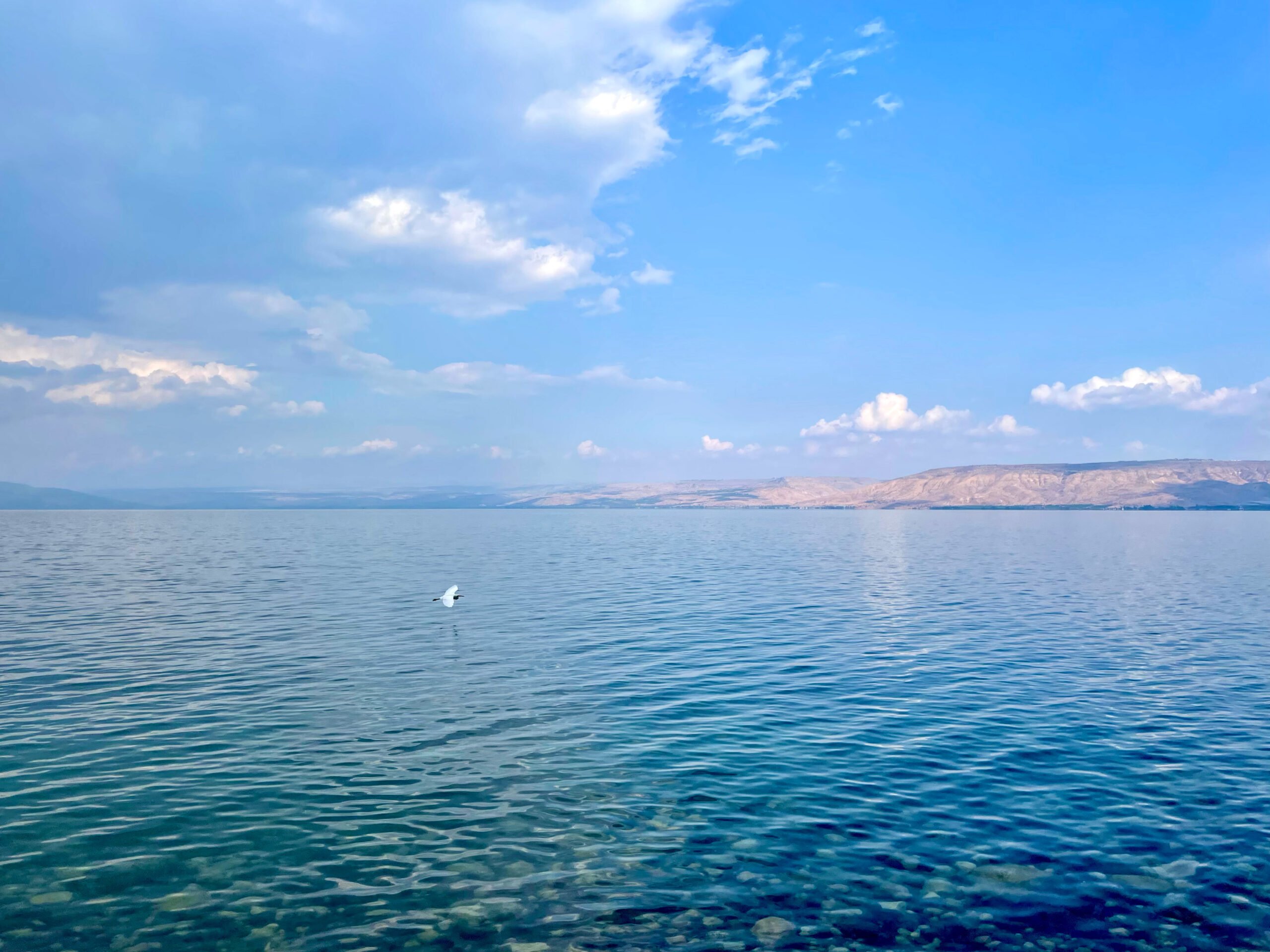
Groundwater
Coastal Aquifer
The Coastal Aquifer is a freshwater body that lies not far below the surface and extends along the coastal plain from Carmel in the north to the Gaza Strip in the south (Map 2). In recent years, the aquifer has been subject to pollution from seepage of agricultural chemicals, such as fertilizers and pesticides. It is also increasingly subject to seawater infiltration due to over-pumping.
According to the Hydrological Service of Israel, about 15% of the water pumped from the Coastal Aquifer does not meet drinking water standards for chloride and nitrate concentrations. In addition, many wells are contaminated by industrial waste, runoff of pesticides and fertilizers from farms and sewage sludge. Consequently, over 40% of the wells operating in 1980 are no longer in use.
The situation is even worse for those portions of the Coastal Aquifer that underlie the Gaza Strip. Around 96% of Gaza’s groundwater is undrinkable due to over-pumping and seawater infiltration. On average, the water contribution of the Coastal Aquifer to the Israeli water sector is estimated at about 240-300 MCM/yr.[2]
Mountain Aquifer
The Mountain Aquifer (Map 2) is the largest groundwater reservoir in Israel in terms of annual water supply and water quality. While the safe yield of the aquifer amounts to 360 MCM/yr, around 600 MCM/yr of water is currently extracted, which is a third of Israel’s overall freshwater consumption. With desalination set to increase in the future, water consumption from the Mountain Aquifer is expected to decline.
Underneath the freshwater body in the aquifer lies a saltwater body. Increased use of the groundwater may cause saline seepage. In the northern basin, this phenomenon has been observed as a result of over-pumping in boreholes located at the foot of the mountain range. However, desalination has led to the recovery of all groundwater levels in Israel, and today the Israel Water Authority is maintaining them above green lines .
While the natural water quality of the Mountain Aquifer is good, its water is still exposed to soil and water pollution. Access to the aquifer water is relatively difficult compared to the Coastal Aquifer or the Sea of Galilee. The Mountain Aquifer extends below areas controlled by Israel and below areas controlled by the Palestinian Authority, which makes management of the aquifer more complex.
Non-conventional water sources
Desalination
Since there is a constant shortage of natural water in Israel, desalinated water serves as an important source in the water economy. Israel has five main desalination plants, which provide 50% of all potable water in the country. See the ‘Water Infrastructure in Israel’ section for more information on desalination.
Wastewater
Wastewater reuse is an important source of water for agriculture in Israel. Wastewater that is treated and used for irrigation is known as effluent. The rate of effluent use in Israel is one of the highest in the world. Recovery is carried out using dozens of wastewater treatment plants that provide over 660 MCM/yr. This amount is about 50% of the total water demand for agriculture and about 25% of the total water demand in the country.[1] [3]
Domestic sewage is collected and treated by Israel’s national water company Mekorot, or by private companies. Private wastewater treatment facilities normally operate in smaller outlying communities whereas Mekorot treats sewage from the larger urban centres. Israel aims to more than double the amount of effluent that is produced for the agricultural sector by 2050. Although effluent increases supply to the national system, it may have environmental side effects like the spread of various waterborne diseases, contamination risks through leaching, and release of toxic and pharmaceutical substances.[3] [4]
New research shows that water reclamation cannot be considered as a backup solution in the event of reduced water availability when a high percentage of the wastewater is already being treated and recycled and water savings are encouraged.[5] This suggests that for Israel’s future water management strategy, an additional increase in water reclamation will not be the main strategy.
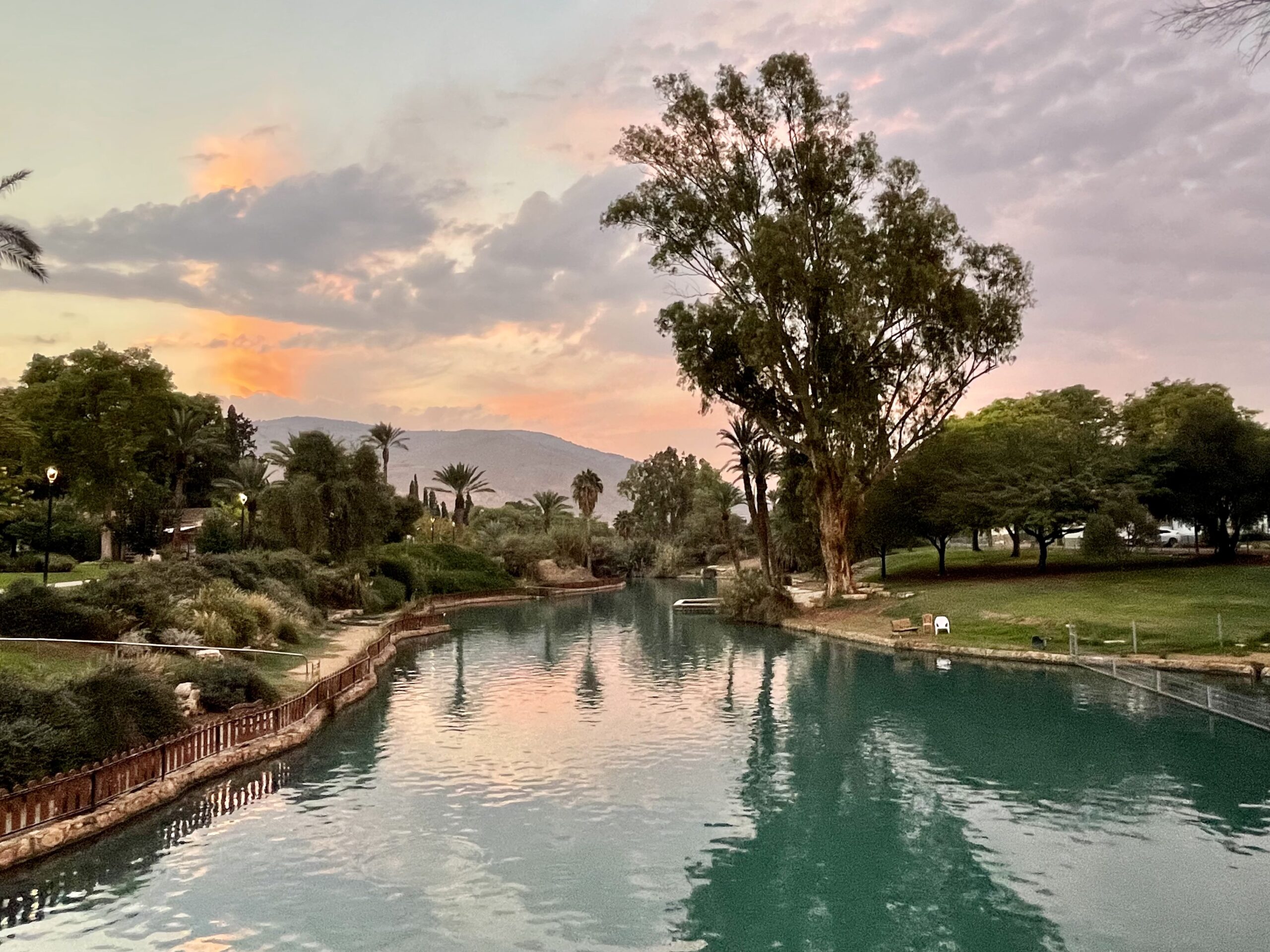
Political context
The political climate in the Middle East makes it impossible to discuss water without addressing the political context that has shaped its availability. The roots of Israel’s water conflict can be traced back to the British Mandate period (1923-1948), when the British government commissioned the hydrologist Michael Ionides to conduct a study of the water resources and irrigation potential in the Jordan Valley Basin. This formed the main reference for the 1947 United Nations Partition Plan, which recommended the division of British Mandate Palestine into a Jewish and an Arab state.
Following the 1948 war and the establishment of the State of Israel, the new government launched a project to divert water from the Jordan River to the Negev region in the south of the country through the National Water Carrier (NWC). Construction of the NWC started in 1953 but was halted after Arab objections to the project. In 1955, the United States presented the Johnston Plan in a bid to resolve the dispute. However, the plan, which outlined water distribution quotas for the countries sharing the Jordan River Basin (at the time Israel, Jordan, Lebanon and Syria), was never ratified and the countries began exploiting the resource unilaterally.[6]
In 1964, Syria began building dams to divert water from the Banias and Dan rivers in the Golan Heights. Israel considered these water diversions to be a threat to its water resources and destroyed the dams. Some scholars contend that this was one of the triggers of the Six Day War in 1967, in which Israel gained control of the Sinai Peninsula, the Gaza Strip, the West Bank, the Golan Heights and their respective water resources.
After its occupation of the West Bank and Gaza in 1967, Israel gained military control of the Palestinian Territories and imposed severe restrictions on Palestinian water resources. The banks of the Jordan River became a closed military zone and Palestinians were deprived of access to the only surface water resource in the West Bank. Israel also introduced several regulations restricting Palestinian access to water and revoking all Palestinian control over the only groundwater resource in the area, the Mountain Aquifer. The Oslo Accords of 1993 and 1995 gave Palestinians hope that they would gain sovereignty over their water resources. However, the outline agreements have yet to be fully ratified.
Today, Israel maintains control of most of the Palestinian water resources, including full control over the Mountain Aquifer in the West Bank. The average Palestinian receives 60-90 litres of water per day (L/d), below the World Health Organization’s minimum amount of 100 L/d.
The quality and quantity of water in Israel and Palestine have been deteriorating steadily since the beginning of the occupation. Moreover, natural water resources in the region are not shared equitably and are at risk of being permanently degraded or lost due to overuse and pollution.[7]
Israel’s occupation of the Golan Heights is also important for the country’s water security. Rainwater draining from the Golan is a crucial water source for Israel’s largest freshwater reservoir, the Sea of Galilee. Furthermore, the Banias River, a tributary of the Jordan River that originates in the Golan Heights, forms an important water resource in itself and also drains into Sea of Galilee.[8] The shared nature of freshwater resources and the ongoing degradation of these resources continue to be a source of tension in the region and a major issue in the Israeli-Palestinian conflict.
[1] Kramer, I., Tsairi, Y., Roth, M.B., Tal, A. and Mau, Y., 2022. ‘Effects of population growth on Israel’s demand for desalinated water.’ npj Clean Water 5, 67.
[2] Israel Water Authority, 2018. Hydrological data Mountain Aquifer.
[3] Tenne, A., 2010. Sea Water Desalination in Israel: Planning, Coping with Difficulties, and Economic Aspects of Long-term Risks. Israel Water Authority – State of Israel Desalination Division.
[4] Roth, M.B. and Tal, A, 2022. ‘The ecological tradeoffs of desalination in land-constrained countries seeking to mitigate climate change.’ Desalination 529, 2022, 115607.
[5] Luckmann, J., Grethe, H. and McDonald, S., 2016. ‘When water saving limits recycling: Modelling economy-wide linkages of wastewater use.’ Water Research 88: 972-980.
[6] Salem, H.S. and Isaac, J., 2007. ‘Water agreements between Israel and Palestine and the region’s water argumentations between policies, anxieties and unsustainable development.’ A keynote paper presented at the International Conference on Green Wars: Environment between Conflict and Cooperation in the Middle East and North Africa (MENA). Beirut, Lebanon, November 2-3, 2007.
[7] Amnesty International, 2017. ‘The occupation of water.’ Published on 29 November 2017.
[8] Inbar, E., 2011. ‘Israeli control of the Golan Heights: High strategic and moral ground for Israel.’ Mideast Security and Policy Studies No. 90.

